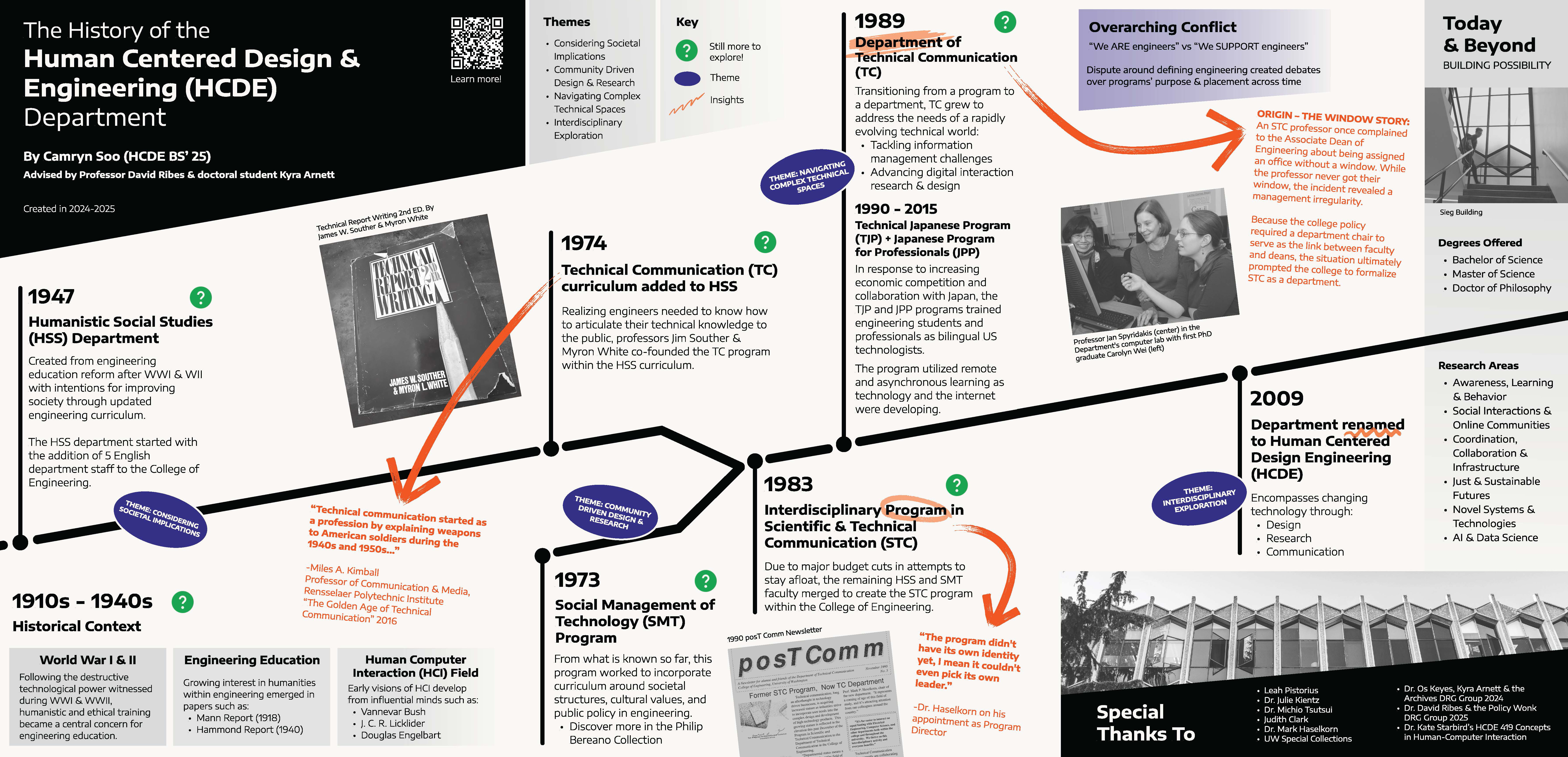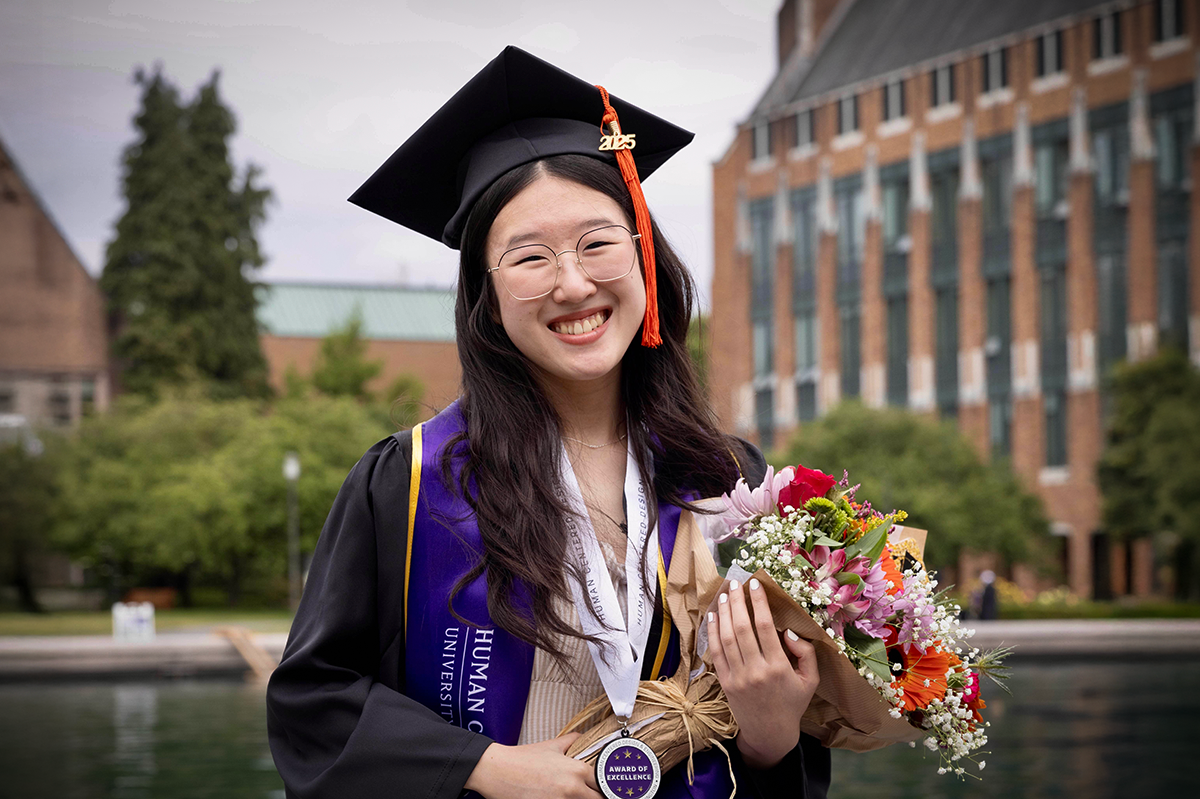David Ribes, HCDE professor
Kyra Arnett, HCDE PhD student
Camryn Soo, HCDE BS ‘25 alumna
The department of Human Centered Design & Engineering (HCDE) has worn many names across the years. We became HCDE in 2008; before that, we were called Technical Communication, and earlier still, the Social Management of Technology. In our earliest post-World War II years, we were known as Humanistic Social Studies. This long and winding history has influenced who we are today and fuels our enduring interest in the relationship between people and technology.
But we do not know our full history.
Investigating history is part of research in HCDE, including unearthing our own. What follows is a work in progress (see here for a publication on doing technical histories). There is still much to rediscover about the department, our faculty, our students, and the ways we have engaged with scholarship, engineering, and the world over the years.
Below you will find a work-in-progress poster, outlining some of what we know about HCDE’s history. We have also provided links to historical archives that contain even more materials to browse. There is much more waiting to be uncovered. If you are interested in exploring these archives and helping us piece together this story, please contact Leah Pistorius, HCDE communications manager, at lepisto@uw.edu.
Three-panel exhibit on view in Sieg Building
By Camryn Soo (HCDE BS '25), advised by HCDE Professor David Ribes and doctoral student Kyra Arnett.
Humanistic Social Studies
Founded in the years following World War II, Humanistic Social Studies (HSS) was in part a reaction to the magnified role of technical expertise in modern war, such as for developing or aiming artillery, and of course, the atomic bomb. WWII provoked a crisis of reflexivity for engineers, and so too in how we train them. What is the social and ethical role of the professional engineer? And how should a College of Engineering prepare future engineers to reflect social values?
HSS aimed to shape the professional character of engineers by humanizing technical subjects and broadening the curriculum to include society’s improvement as a core concern. Yet the relation between war, security, and engineering has remained a complicated and ongoing challenge, one that continues to shape conversations within HCDE and engineering more broadly.
Social Management of Technology Program
The Social Management of Technology (SMT) program explored the relationship between technological development and its intersection with public policy, society, and values. Professor Edward Wenk, Jr., who joined UW in the early 1970’s, served as program’s founding director and held joint appointments in Engineering and at the School of Public Affairs — adding another layer of interdisciplinarity to what would eventually become HCDE.
During its core years, SMT researchers took on projects that linked technology to pressing societal concerns, such as:
- Evaluating State Implementation of Federal Highway Policy (1976)
- Evaluating Decentralized Electricity for Washington (1981), conducted for the WA Legislature
- National Research Council study on the social and economic impacts of the Trojan Nuclear Power Plant
One influential professor in the SMT program was Phil Bereano. At the intersection of technology, ethics, and society, Professor Bereano was an activist who, throughout his work, championed public participation as a way to bridge the gap between scientific innovation and governmental decision-making. Professor Bereano's work reflects the potential impact the SMT program sought to achieve with its students.
UW Library Special Collections reports holding 24 cubic feet of SMT administrative records from those years — a reminder that there is much more to uncover about the program and its legacy.
Technical Communication
Technical communication grew out of the Humanistic Social Studies curriculum through the work of Professors Jim Souther and Myron White. Initially developed to help engineers communicate technical information to the public, it evolved into a field in its own right, one that emphasized clarity, accessibility, and the responsibility of engineers and scientists to make complex information understandable to diverse audiences. In 1989, Technical Communication became its own department, serving as the direct predecessor of HCDE.
While we left behind the label “Technical Communication” in 2009, HCDE continues to carry the spirit of that field. Our work still focuses on making technical materials more accessible, unpacking what might otherwise remain “black boxed,” and in doing so, contributing to a more democratic exchange of knowledge.
Related story
STUDENT HIGHLIGHT
HCDE alumna Camryn Soo explores the undefinable roots of HCDE
Camryn Soo (HCDE BS '25) spent two years researching the department’s history, tracing its roots in post-war efforts to bring more humanities into engineering education. Through archival research, interviews, and coursework, she uncovered how decades of curricular innovation and cross-disciplinary programs shaped HCDE into what it is today.
Technical Japanese Program & Japanese Program for Professionals
In the 1980s, as Japanese technical industries rose to global prominence, HCDE launched programs to prepare US engineers and professionals for bilingual collaboration. Founded and directed by Professor Michio Tsutsui, the Technical Japanese Program (TJP) focused on technical combined graduate-level engineering study with Japanese language instruction for students already proficient in Japanese. Its companion program, the Japanese Program for Professionals (JPP), offered tailored language training for working professionals in key technology fields.
These programs reflected how national economic and security concerns led to shifts in the department’s curriculum, aligning educational priorities with global industry needs and shifting ideas of what it means to prepare engineering students for their careers. If you are interested in learning more about this program, you can explore this presentation.
Human Centered Design & Engineering
In 2009, the department adopted its current name: Human Centered Design & Engineering (HCDE). Our mission and vision are captured in our guiding phrase — We Build Possibility.
Today, HCDE is home to thriving undergraduate, master's, and doctoral programs. We engage across the College of Engineering and the wider university through teaching, collaboration, and research.
True to our history, we remain deeply interdisciplinary. Our faculty, students, and research groups explore a wide range of topics, including:
- Awareness, Learning, and Behavior
- Social Interactions and Online Communities
- Coordination, Collaboration, and Infrastructure
- Just and Sustainable Futures
- Novel Systems and Technologies
- Al and Data Science
What will HCDE be next?
Our history is still unfolding. If you are interested in learning more, or would like to help us uncover more of it, we welcome your involvement. Additional unprocessed historical materials are available, including research proposals, meeting notes, and letters or emails. Please contact Leah Pistorius (lepisto@uw.edu), HCDE communications manager, if you would like to access these sources.
Special Collections
UW Special Collections also holds extensive archival materials related to the history of the department. Key collections include:
- UW President Records — contains information on the Humanistic Social Sciences department (Accession 71-034, box 62).
- Charles A. Sleicher Papers — (Professor of Chemical Engineering) contains documents related to the Humanistic Social Sciences department.
- UW College of Engineering Records — include documents on the department of Humanistic Social Sciences and may also include information on Technical Communication.
- UW Program in Social Management of Technology — includes correspondence, minutes, reports, program and project files (among others) related to the program.
- Philip Bereano papers — (Professor in Social Management of Technology) includes documents related to his professional work and activism.
- Edward Wenk papers — (Professor in the College of Engineering and SMT) includes documents related to the SMT program and his own research.
These archives hold stories still waiting to be pieced together. As we reflect on our past and look toward the future, we invite you to join us in imagining what HCDE will become next.

